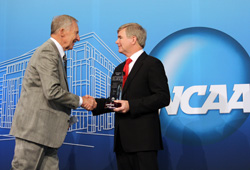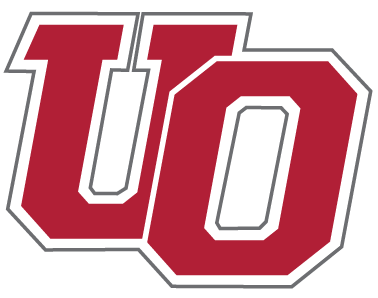
 By Zach Dirlam
By Zach Dirlam
Former NCAA president Cedric Dempsey could have started a
professional baseball career in the Boston Red Sox organization, or
accepted a scholarship to play Division I basketball, but he turned
it all down to become a three-sport athlete at Albion College in
1950.
The Michigan Wolverines, Michigan State Spartans, Minnesota Golden Gophers and Beloit Buccaneers were all recruiting Dempsey. Meeting Albion’s basketball coach, Walter Sprandel, shortly after his high school career ended changed everything, though.
“I played my last high school game at Albion. That was the first time I’d been on campus,” Dempsey recalled. “I was very impressed with Coach Sprandel.”
Although the more prominent opportunities were difficult to turn down, Dempsey could tell there was something special about Albion.
“I felt very comfortable from the beginning,” Dempsey said. “I fell in love with the campus and decided that was the best fit for me. I never regretted it.”
Over the course of his four years as a Briton, Dempsey earned 11 varsity letters. The Illinois native was a two-way end for the football team, a pitcher on the baseball diamond and a center under the tutelage of Coach Sprandel. In his four years at Albion, Dempsey played center, guard, and forward depending on where he was most needed.
Dempsey excelled at all three sports. He was a three-time all-Michigan Intercollegiate Athletic Association pick in basketball and in baseball for two years. His vertical leaping abilities helped him become a dominant force for the Britons on the hardwood.
As a freshman, Dempsey helped Albion capture the 1951 MIAA
basketball title. The Britons struggled to piece things together
the following two years, though.
Albion finished 8-4 in Coach Sprandel’s final season at the helm, and only managed to compile an 8-11 overall record in Elkin Isaac’s first year as head coach in 1952-53. In 1953-54, the Britons bounced back and won its first 13 games and finished 17-3.
At this time, however, there were more important things going on across the country than simply playing basketball. Integration in college athletics had been relatively unheard of in the 1950s, but Albion had a different view on the matter.
“We had one of the most integrated teams. It was certainly the first one at Albion in any sport, and probably one of the first in the country,” Dempsey said with great pride. “I learned a lot about the integration of minority groups through sport.”
The diverse group of Britons all came together to set a school record with 17 wins in 1953-54. Dempsey also won the MIAA’s most valuable player award as a senior thanks to his 22.5 rebounds per game, which ranked second in the nation.
However, success on the court did not mean as much to Dempsey as
the lessons he learned off of it.
“The learning experiences I had at Albion had a tremendous impact…I remember (those) more than the wins and losses,” Dempsey said. “I had great teammates and had some wonderful coaches, particularly Walt Sprandel and Elkin Isaac.
“Mr. Sprandel was probably the worst basketball technician I’ve played for, but as a teacher he was by far the best for whom I ever played.”
Dempsey didn’t have much time to rest during his time at Albion either. For his first three years at the college, Dempsey delivered mail in Seaton Hall and worked as a dishwasher at the old dining room. As a senior, he worked as a janitor at The Albion Recorder for 2-4 hours after practices concluded.
Officiating basketball games also helped Dempsey keep some extra money in his pocket for he and his wife, June, whom he married in his final year at Albion. They celebrate 60 years of marriage this August.
Shortly after Dempsey earned his undergraduate degree, Walled Lake (Mich.) High School asked him to become the head coach of its basketball program. A conversation with Coach Sprandel sent Dempsey down a different path, though.
“I was really excited,” Dempsey grinned. “I went up to see Mr. Sprandel, and he said, ‘You’re not going to take that job. You’re going to stay here, get your master’s degree and in a couple of years that job will still be there and maybe there will be other opportunities.’”
So, Dempsey followed Coach Sprandel’s words of advice and stayed at Albion for another two years. From 1954-56, Dempsey served as an assistant coach for the football and basketball teams. Dempsey was also head coach of the Britons’ tennis team during this time period.
Upon receiving his master’s degree, Dempsey received yet another basketball coaching offer. This time Adrian College extended its hand to Dempsey. Once again, Coach Sprandel advised Dempsey to continue his education and earn a doctorate.
Dempsey chose to attend the University of Illinois where he “struggled through” exercise physiology and learning French and German. Nearly three years later, Dempsey had a chance to finish his doctorate, return to Albion and take over as head coach of the basketball and cross country teams.
“I’d finished all of my coursework at Illinois and started on my dissertation,” Dempsey explained. “I had collected all of the data I was going to use in writing the dissertation, so it seemed like a reasonable time to go out and get a job, and I had a great love for Albion.
“My heart was there, my emotions were there, I needed money and I thought I could do it.”
Part of the way through Dempsey’s third year back at Albion, Coach Sprandel passed away. The college asked Dempsey to replace his mentor as Dean of Men in 1962. Dempsey retained the position in 1963 before leaving to become an assistant professor of health, physical education and recreation at the University of Arizona.
The new job would allow Dempsey to teach graduate classes and be an assistant basketball coach. Dempsey’s daughter had also fallen ill with pneumonia her first three winters, and doctors advised the family to move to a warmer climate.
“That was a tough call. It took June and me four months to make our minds to leave Albion,” Dempsey said.
Two years later, Dempsey became an assistant athletic director at Arizona. Dempsey held that position until 1967, when he left to become the athletic director and chair of the HPER Department at the University of the Pacific.
Dempsey would not relocate again until 1979 when he took the same position at San Diego State University. After a six-month stint with the Aztecs, Dempsey moved east to head the University of Houston’s athletic department.
In 1982, Dempsey jumped at the chance to return to Arizona and serve as its athletic director. Dempsey’s 12-year tenure in Tucson was a huge success.
Not only did Dempsey hire Dick Tomey, who led the Wildcats to national prominence on the football field, he also lured legendary head basketball coach Lute Olson away from the Iowa Hawkeyes in 1983.
Arizona’s baseball, men’s golf and softball teams all won national titles during Dempsey’s time as athletic director.
Additionally, the athletic department had a budget surplus every year after 1985 under Dempsey’s leadership.
During this time, Dempsey also served as the NCAA’s secretary-treasurer for one year and chaired the NCAA Division I men’s basketball committee. Both were volunteer positions that helped bolster Dempsey’s bid for NCAA president in 1994.
“I had a real concern at that time about the direction the NCAA was going to be taking, so I agreed to be a candidate,” Dempsey said. “It was a tough move for us. June had a very good job at Arizona and we never thought about leaving.
“There were some morale problems at the national office and within the membership. There were certainly some concerns about the leadership of the association, and I felt somewhat obligated to try to help my profession at the time.”
As NCAA president, Dempsey’s first priority was to restructure the association. Dempsey created an executive committee of 16 college presidents. The Association was federated into three distinct divisions. Now, each division may decide upon legislation that is in the best interest of their division.
“That was a difficult process, but it worked out well,” Dempsey said of the restructuring. “Presidents at each division took more responsibility for the direction of the association.”
Another move Dempsey felt needed to be made involved the NCAA’s central office. The association had been located in Kansas City, Mo., from 1950 until 1999. Dempsey led the office move to Indianapolis, Ind., which was a savings of $54 million to the NCAA.
What Dempsey will be remembered for the most, though, are the television contracts signed under his watch. Dempsey helped the NCAA negotiate an 11-year, $6.2 billion deal with CBS, which became active in 2003. It was the largest single contract in sports history at that time.
 Dempsey retired as NCAA president on Jan. 1, 2003, but he left
behind a lasting legacy. This became clear in 2006 when Dempsey
found his name on a list of the NCAA’s 100 Most Influential
Student Athletes. To put this in perspective, other names on the
list include Kareem Abdul-Jabbar, Ervin “Magic”
Johnson, Jackie Robinson and Gerald R. Ford. In October 2012 the
NCAA named its office building in Indianapolis after Dempsey
(pictured left with current NCAA President Mark Emmert) in
recognition of his contribution to intercollegiate athletics.
Dempsey retired as NCAA president on Jan. 1, 2003, but he left
behind a lasting legacy. This became clear in 2006 when Dempsey
found his name on a list of the NCAA’s 100 Most Influential
Student Athletes. To put this in perspective, other names on the
list include Kareem Abdul-Jabbar, Ervin “Magic”
Johnson, Jackie Robinson and Gerald R. Ford. In October 2012 the
NCAA named its office building in Indianapolis after Dempsey
(pictured left with current NCAA President Mark Emmert) in
recognition of his contribution to intercollegiate athletics.
Albion has bestowed Dempsey with several honors as well. The college voted Dempsey into its Athletic Hall of Fame in 1989, followed by a distinguished alumni award in 1993, an honorary doctor of laws in 1995 and a lifetime achievement award in 2002.
These days, Dempsey is technically retired, however he spends much of his time advising athletic departments and helping with athletic director searches.
Dempsey also finds time to travel the world with his wife, and enjoys living in the warm climate of La Jolla, Calif.











